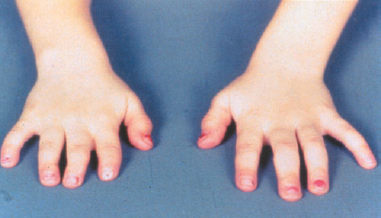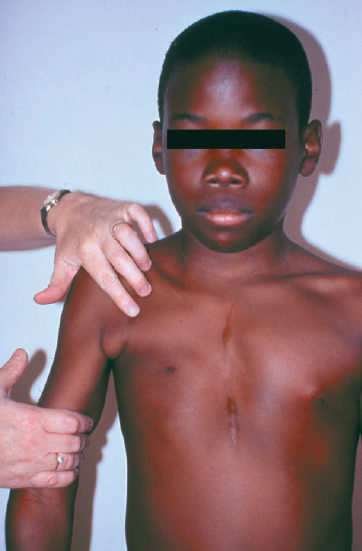78
Brachydactyly
Scott H. Kozin
History and Clinical Presentation
A 5-year-old girl presented with a small right hand, mild webbing of the fingers, and an ipsilateral chest wall deformity. She is a product of a full-term, spontaneous, vaginal delivery. There were no problems during the pregnancy or at the time of delivery. She is otherwise healthy and has obtained normal developmental milestones (e.g., sitting, walking, and talking) at the appropriate time. There is no family history of similar deformities, including three siblings.
Physical Examination
The patient is a healthy-appearing female with normal appearance and stature. The right chest wall appeared sunken with absence of the sternocostal portion of the pectoralis major muscle. Shoulder, elbow, and wrist had full motion and strength. The right hand was slightly smaller than the left, with mild webbing of the second (index-long) and third (long-ring) web space (Fig. 78–1). She had full dexterity of her digits and was able to form a full fist and claw.
Diagnostic Studies
Radiographs of the chest and shoulder were normal. Several views of the hands revealed mild webbing of the second and third web spaces and shortened digits on the right hand, primarily at the middle phalangeal level (Fig. 78–2).
PEARLS
- All children with a hypoplastic hand should have their chest wall examined.
- Brachydactyly combined with syndactyly is often associated with Poland’s syndrome.
- Brachydactyly is most common at the middle phalanx level.
- Mild brachydactyly usually does not interfere with function.
PITFALLS
- Avoid surgery on mild brachydactyly.
- Avoid distraction osteogenesis at the phalangeal level in brachydactyly.
Differential Diagnosis
Brachydactyly associated with Poland’s syndrome
Clinodactyly
Camptodactyly
Pseudohypoparathyroidism
Pseudopseudohypoparathyroidism

Figure 78–1 A 5-year-old child with small right hand and mild syndactyly of the second and third web spaces.

Clinodactyly is angular deformity of the digit in the coronal plane, usually of the small finger in a radial direction. The middle phalanx is usually asymmetrically short with an inclination toward the ring finger. Camptodactyly is a nontraumatic proximal interphalangeal joint contracture with angulation in the sagittal plane. Pseudohypoparathyroidism or pseudopseudohypoparathyroidism is an X-linked or autosomal-dominant condition associated with brachydactyly of the ring and small digits at the metacarpal level. The shortened metacarpals produce an appearance of absent knuckles of these digits upon forming a fist (knuckle, knuckle, bump, bump). The child is of short stature and often obese.
Diagnosis
Brachydactyly
Brachydactyly is used as a generalized term for digital hypoplasia. However, brachydactyly strictly refers to a short hypoplastic digit that has the normal complement of bones. The shortening usually involves the middle phalanx, which is the last phalanx to ossify. The index and small fingers are most commonly affected. The size and length discrepancy of the digit do not improve with growth and may increase throughout childhood. The extent of shortening is variable, and it influences the treatment decision process.
Brachydactyly can also occur in conjunction with numerous syndromes, especially Poland’s syndrome. Poland’s syndrome is usually sporadic in occurrence and combines hand hypoplasia with chest wall abnormalities. The most common hand anomaly is symbrachydactyly (syndactyly combined with brachydactyly), and the typical chest abnormality is ipsilateral absence of the sternocostal portion of the pectoralis major muscle (Fig. 78–3). However, more severe hand and chest wall problems can occur, such as absence of digits, breast, and nipple. Brachydactyly can also occur with other syndromes, including de Lange’s, Treacher Collins, and trisomy 21.










